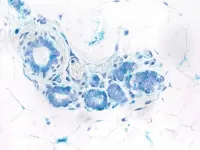(Press-News.org) PULLMAN, Wash. -- Washington State University researchers have developed an innovative way to convert plastics to ingredients for jet fuel and other valuable products, making it easier and more cost effective to reuse plastics.
The researchers in their reaction were able to convert 90% of plastic to jet fuel and other valuable hydrocarbon products within an hour at moderate temperatures and to easily fine-tune the process to create the products that they want. Led by graduate student Chuhua Jia and Hongfei Lin, associate professor in the Gene and Linda Voiland School of Chemical Engineering and Bioengineering, they report on their work in the journal, Chem Catalysis.
"In the recycling industry, the cost of recycling is key," Lin said. "This work is a milestone for us to advance this new technology to commercialization."
In recent decades, the accumulation of waste plastics has caused an environmental crisis, polluting oceans and pristine environments around the world. As they degrade, tiny pieces of microplastics have been found to enter the food chain and become a potential, if unknown, threat to human health.
Plastics recycling, however, has been problematic. The most common mechanical recycling methods melt the plastic and re-mold it, but that lowers its economic value and quality for use in other products. Chemical recycling can produce higher quality products, but it has required high reaction temperatures and a long processing time, making it too expensive and cumbersome for industries to adopt. Because of its limitations, only about 9% of plastic in the U.S. is recycled every year.
In their work, the WSU researchers developed a catalytic process to efficiently convert polyethylene to jet fuel and high-value lubricants. Polyethylene, also known as #1 plastic, is the most commonly used plastic, used in a huge variety of products from plastics bags, plastic milk jugs and shampoo bottles to corrosion-resistant piping, wood-plastic composite lumber and plastic furniture.
For the process, the researchers used a ruthenium on carbon catalyst and a commonly used solvent. They were able to convert about 90% of the plastic to jet fuel components or other hydrocarbon products within an hour at a temperature of 220 degrees Celsius (428 degrees Fahrenheit), which is more efficient and lower than temperatures that would be typically used.
Jia was surprised to see just how well the solvent and catalyst worked.
"Before the experiment, we only speculated but didn't know if it would work," he said. "The result was so good."
Adjusting processing conditions, such as the temperature, time or amount of catalyst used, provided the critically important step of being able to fine-tune the process to create desirable products, Lin said.
"Depending on the market, they can tune to what product they want to generate," he said. "They have flexibility. The application of this efficient process may provide a promising approach for selectively producing high-value products from waste polyethylene."
With support from the Washington Research Foundation, the researchers are working to scale up the process for future commercialization. They also believe their process could work effectively with other types of plastics.
INFORMATION:
The work, which was done in collaboration with researchers from the University of Washington and Pacific Northwest National Laboratory, including Professor Jim Pfaendtner. It was funded by the Washington State Research Foundation and the National Science Foundation.
What The Study Did: Researchers assessed the feasibility of using positive behavior supports to promote the use of face coverings in school-aged children with autism spectrum disorders and/or attention-deficit/hyperactivity disorder (ADHD) attending a summer program during the COVID-19 pandemic.
Authors: Benjamin Aaronson, Ph.D., of the University of Washington in Seattle, is the corresponding author.
To access the embargoed study: Visit our For The Media website at this link https://media.jamanetwork.com/
(doi:10.1001/jamanetworkopen.2021.10281)
Editor's Note: The article includes conflicts of interest disclosures. Please see the article for additional information, including other authors, author ...
What The Study Did: Hospital discharge rates, hospitalization outcomes and demographic factors were examined among U.S. patients with ischemic stroke before and during the COVID-19 pandemic.
Authors: Adam de Havenon, M.D., of the University of Utah in Salt Lake City, is the corresponding author.
To access the embargoed study: Visit our For The Media website at this link https://media.jamanetwork.com/
(doi:10.1001/jamanetworkopen.2021.10314)
Editor's Note: The article includes conflict of interest and funding/support disclosures. Please see the article for additional information, including other authors, author contributions and affiliations, conflict of interest ...
What The Study Did: Online search data were used to assess changes in home birth information seeking across the United States and United Kingdom during the COVID-19 pandemic.
Authors: Christina N. Schmidt, B.S., of the University of California, San Francisco, is the corresponding author.
To access the embargoed study: Visit our For The Media website at this link https://media.jamanetwork.com/
(doi:10.1001/jamanetworkopen.2021.10310)
Editor's Note: Please see the article for additional information, including other authors, author contributions and affiliations, conflict of interest and financial disclosures, and funding and support.
INFORMATION:
Media advisory: The full study is linked to this news release.
Embed this link to provide your readers free access ...
Early diagnosis and improvement of breast cancer treatments have reduced breast cancer mortality in recent years, with survival rates reaching 85% today. In spite of these data, breast cancer was still the most frequently diagnosed tumour in the world in 2020, mainly due to increased population screening and social factors such as ageing. RANK protein plays a key role in the development of these tumours. Located in the membrane of cells, when it binds to its partner RANKL, it sends signals that stimulate the development of the mammary gland. When these proteins do not work properly, breast cells begin to divide and multiply ...
Mitochondria - the 'batteries' that power our cells - play an unexpected role in common diseases such as type 2 diabetes and multiple sclerosis, concludes a study of over 350,000 people conducted by the University of Cambridge.
The study, published today in Nature Genetics, found that genetic variants in the DNA of mitochondria could increase the risk of developing these conditions, as well influencing characteristics such as height and lifespan.
There was also evidence that some changes in mitochondrial DNA were more common in people with Scottish, Welsh or Northumbrian genetic ancestry, implying that mitochondrial DNA and nuclear DNA (which accounts for 99.9% of our genetic make-up) interact with each other.
Almost ...
Scientists have succeeded in dating some of the oldest stars in our galaxy with unprecedented precision by combining data from the stars' oscillations with information about their chemical composition.
The team led by researchers at the University of Birmingham, surveyed around a hundred red giant stars, and were able to determine that some of these were originally part of a satellite galaxy called Gaia-Enceladus, which collided with the Milky Way early in its history.
The results, published in Nature Astronomy, revealed that the group of stars surveyed all have similar ages, or are slightly younger than the majority of the stars known to have started their lives within the Milky Way. This corroborates existing theories suggesting the Milky Way had already started forming a significant ...
In the largest genetic study of bipolar disorder to date, researchers have identified 64 regions of the genome containing DNA variations that increase risk of bipolar disorder - more than double the number previously identified.
The research team also found overlap in the genetic bases of bipolar disorder and other psychiatric disorders. Furthermore, the study supports a role of sleep habits, alcohol, and substance usage in the development of bipolar disorder, although further research is needed to confirm these findings. The study results are published May 17 in Nature Genetics.
Bipolar disorder, a complex psychiatric disorder characterized by recurrent episodes of severely high and low mood, affects an estimated 40 to 50 million people worldwide. It typically begins ...
Researchers from the Francis Crick Institute, Royal Marsden, UCL and Cruces University Hospital have found that cells from different parts of kidney tumours behave differently, and surprisingly, cells within the centre of a tumour are the most aggressive and have the highest chance of spreading around the body.
Cancers can spread to other parts of the body, with cells taking hold as secondary tumours which make the disease much harder to treat. Understanding the mechanics of this spread, a process called metastasis, could lead to new treatments that block this migration.
In their multidisciplinary study ...
COLUMBUS, Ohio - New research provides the best evidence to date into the timing of how our early Milky Way came together, including the merger with a key satellite galaxy.
Using relatively new methods in astronomy, the researchers were able to identify the most precise ages currently possible for a sample of about a hundred red giant stars in the galaxy.
With this and other data, the researchers were able to show what was happening when the Milky Way merged with an orbiting satellite galaxy, known as Gaia-Enceladus, about 10 billion years ago.
Their results were published today (May ...
Patients with both diabetes and heart failure who were treated with sotagliflozin, a novel investigational drug for diabetes, for a median of nine to 16 months experienced reductions of 22% to 43% in the risk of death or worsening heart failure compared with similar patients who were treated with a placebo. The drug was effective in patients with all forms of heart failure, including those whose heart muscle is abnormally stiff (preserved ejection fraction) and for whom there is currently no effective treatment, according to research presented at the American College of Cardiology's 70th Annual Scientific Session.
"Treatment with sotagliflozin robustly and significantly reduced cardiovascular adverse events across the full spectrum of ...

